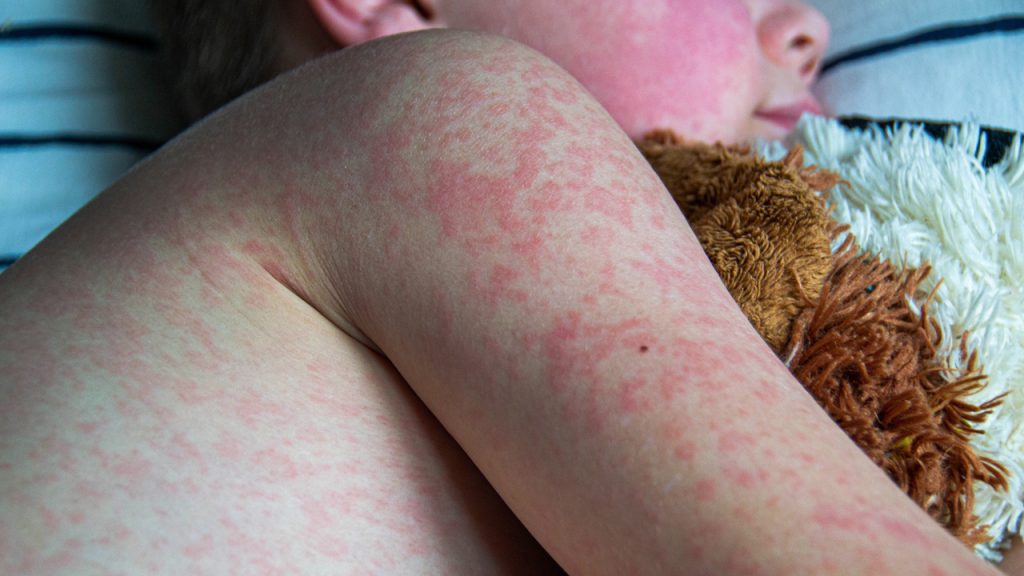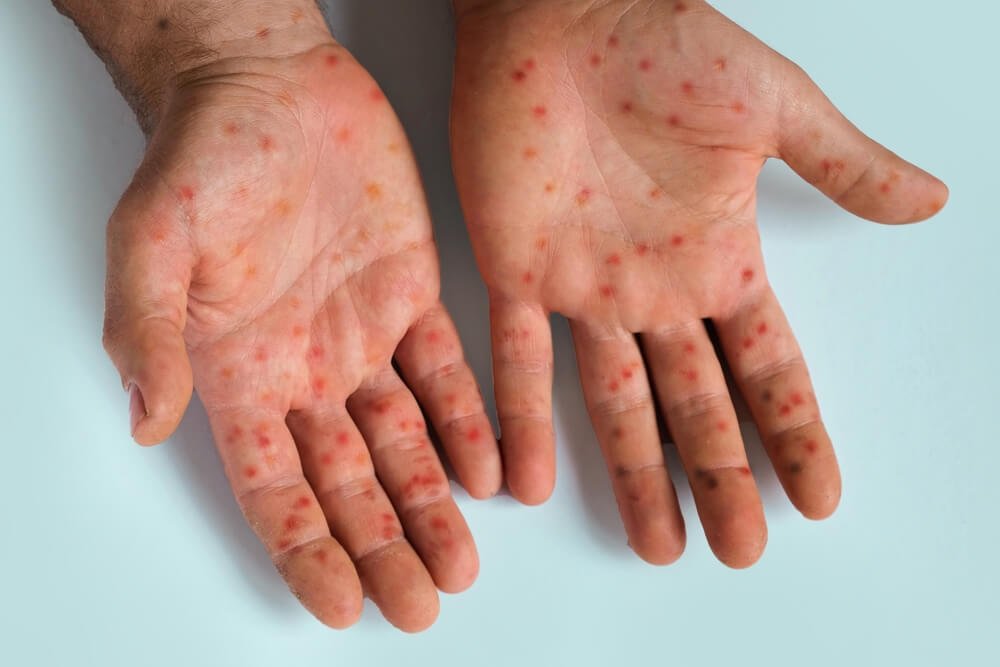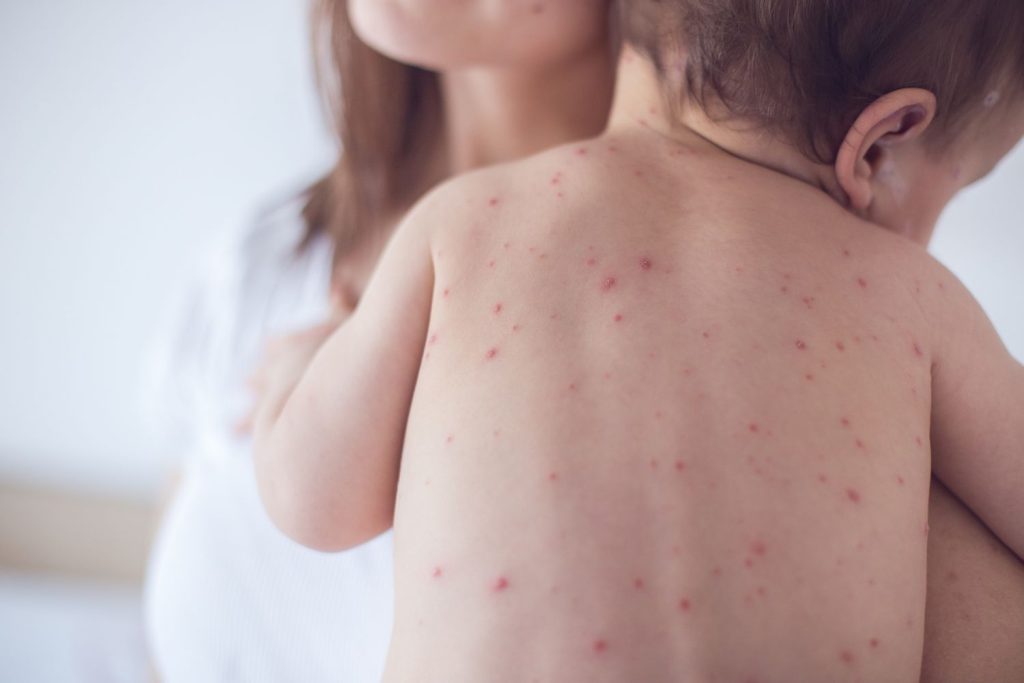Measles is a highly contagious viral infection that spreads through coughing, sneezing, or direct contact with an infected person. It often begins with symptoms like high fever, cough, runny nose, and red, watery eyes, followed by a red rash that starts on the face and spreads across the body. Small white spots, known as Koplik spots, may also appear inside the mouth before the rash develops. Measles can lead to serious complications, especially in young children, including ear infections, pneumonia, diarrhea, and in severe cases, brain swelling (encephalitis) or death. The most effective way to prevent measles is through vaccination with the MMR (measles, mumps, rubella) vaccine, which is typically given in two doses during childhood.

Measles causes :
Measles is caused by the measles virus, a highly contagious virus from the paramyxovirus family. It spreads easily through respiratory droplets when an infected person coughs or sneezes, and it can remain in the air or on surfaces for up to two hours. Once inhaled or touched and transferred to the nose or mouth, the virus enters the body, usually through the respiratory tract, and begins to multiply. The main cause of measles outbreaks is lack of vaccination, especially in areas with low immunization rates. People who have not received the MMR (measles, mumps, rubella) vaccine are at the highest risk of infection. Additionally, children, people with weakened immune systems, and those living in crowded or unsanitary conditions are more vulnerable to catching and spreading the virus.
- Measles virus: A highly contagious virus from the paramyxovirus family.
- Airborne transmission: Spreads through coughing, sneezing, or breathing in contaminated air.
- Surface contamination: The virus can survive on surfaces for up to 2 hours and spread when touched.
- Lack of vaccination: The most common cause of outbreaks, especially in unvaccinated populations.
- Weakened immune system: People with low immunity are more likely to get infected.
- High population density: Crowded areas make it easier for the virus to spread quickly.
- Travel to affected regions: Visiting areas with ongoing measles outbreaks increases risk.

Here are the common symptoms of measles:
Measles symptoms usually begin 10 to 14 days after exposure to the virus and start with a high fever, often over 38.5°C (101.3°F), along with a cough, runny nose, sore throat, and red, watery eyes. These early symptoms are similar to a cold and can last for several days. A distinctive feature of measles is the appearance of Koplik spots, which are small white spots inside the mouth and often appear a day or two before the skin rash. The rash itself typically starts on the face and behind the ears, then spreads downward to cover the rest of the body. As the rash spreads, the fever may become higher. Other symptoms can include fatigue, irritability, and loss of appetite. The illness usually lasts about a week to 10 days, but in some cases, it can lead to serious complications.
- High fever (often over 38.5°C or 101.3°F), usually the first symptom
- Cough
- Runny nose (nasal congestion)
- Red, watery eyes (conjunctivitis)
- Sore throat
- Fatigue and irritability
- Koplik spots – small white spots with bluish centers inside the mouth (a key early sign)
- Red rash that starts on the face and spreads to the rest of the body, usually appearing 3–5 days after symptoms begin
- Loss of appetite

Solutions for Measles :
Although there is no specific cure for measles, the disease can be effectively managed with supportive care and, most importantly, prevented through vaccination. The MMR vaccine (measles, mumps, and rubella), given in two doses during childhood, is highly effective and offers long-term protection. For those infected, treatment focuses on relieving symptoms, such as using fever-reducing medications like paracetamol, ensuring plenty of rest and fluids, and using humidifiers or warm drinks to ease coughing. In some cases, especially in children, vitamin A supplements are recommended to reduce the severity of the illness and prevent complications. To stop the spread of measles, it’s essential to isolate the infected person, maintain good hygiene, and ensure that those around them are vaccinated or immune. With proper care and preventive measures, most people recover fully from measles without serious complications.
Vaccination (MMR Vaccine)
- The best way to prevent measles is through the MMR vaccine (measles, mumps, and rubella), usually given in two doses during childhood.
- It provides long-lasting immunity and is over 97% effective when both doses are received.
Supportive Care (No Cure, but Symptoms Can Be Managed)
- Rest and plenty of fluids to help the body recover
- Fever reducers like paracetamol (acetaminophen) or ibuprofen (not aspirin in children)
- Cough relief with a humidifier or warm fluids
- Vitamin A supplements, especially in children, to reduce the severity of symptoms and complications
Preventing Spread
- Isolate the infected person for at least 4 days after the rash appears
- Practice good hygiene, such as regular handwashing and covering the mouth when coughing or sneezing
- Ensure all close contacts are vaccinated or have immunity
